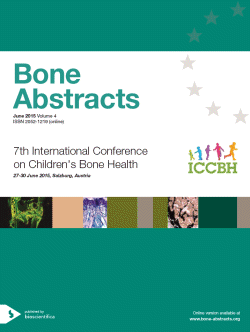
7th International Conference on Children's Bone Health
Salzburg,
Austria
27 Jun 2015 - 30 Jun 2015

Abnormal trabecular micro-architecture and bone mechanical properties in adolescent idiopathic scoliosis: a case–control study with high-resolution peripheral quantitative computed tomography and finite element analysis
Cheuk Ka Yee , Chen Huanxiong , Yu Fiona , Lam Tsz Ping , Lee Simon K M , Ng Bobby K W , Cheng Jack C Y
Feature-based recognition of trabecular microstructure using 1.5T magnetic resonance imaging: a new methodology
Dimitri Paul , Lekadir Karim , Hoogendoorn Corne , Armitage Paul , Whitby Elspeth , King David , Frangi Alejandro
Sedentary time negates the positive influence of moderate-to-vigorous physical activity but not vigorous physical activity on bone strength in adolescent girls
Tan Vina , Macdonald Heather , McKay Heather
Increased bone matrix mineralization in treatment-naive children with Crohn's disease
Roschger Paul , Misof Barbara , Klaushofer Klaus , Rauch Frank , Ward Leanne
Bivariate analyses of BMD and lean mass in children identifies variants with novel pleiotropic effects across six BMD loci and in the TOM1L2 locus
Medina-Gomez Carolina , Kemp John P , Heppe Denise H M , Tobias Jon H , Hofman Albert , Carola Zillikens M , Uitterlinden Andre G , Jaddoe Vincent W V , Evans David M , Rivadeneira Fernando
Early life motor control is positively associated with adolescent bone strength
Ireland Alex , Sayers Adrian , Deere Kevin , Emond Alan , Tobias Jon
Osteogenesis imperfecta: a pilot trial on treatment with the RANKL-antibody denosumab
Hoyer-Kuhn Heike , Netzer Christian , Hero Barbara , Schoenau Eckhard , Semler Oliver
Combination sclerostin antibody and zoledronic acid treatment outperforms either treatment alone in a mouse model of osteogenesis imperfecta
Munns Craig , Peacock Lauren , Mikulec Kathy , Kneissel Michaela , Kramer Ina , Cheng Tegan , Schindeler Aaron , Little David
Skeletal manifestations in pediatric WNT1 osteoporosis
Makitie Riikka , Pekkinen Minna , Laine Christine , Makitie Outi
ba0004oc10 | (1) | ICCBH2015
Lack of PEDF within the bone matrix is associated with osteoidosis and abnormally high bone mineral content
Fratzl-Zelman Nadja , Schmidt Ingo , Roschger Paul , Roschger Andreas , Reich Adi , Glorieux Francis H. , Wagermaier Wolfgang , Fratzl Peter , Klaushofer Klaus , Marini Joan C. , Rauch Frank
ba0004oc11 | (1) | ICCBH2015
Comparison of RANKL blockade and bisphosphonate anti-resorptive therapies in a growing mouse model of OI: implications of prolonged treatment on bone health
Marino Josephine , Pleshko Nancy , Doty Stephen , Carter Erin , Jepsen Karl , Boskey Adele , Raggio Cathleen
ba0004oc12 | (1) | ICCBH2015
A zebrafish osteogenesis imperfecta model: a new tool to develop novel pharmacological treatments
Gioia Roberta , Tonelli Francesca , Carra Silvia , Cotelli Franco , Bianchi Laura , Gagliardi Assunta , Bini Luca , Biggiogera Marco , Leikin Sergey , Fisher Shannon , Rossi Antonio , Tenni Ruggero , Forlino Antonella
ba0004oc13 | (1) | ICCBH2015
Meclozine has a potential effects on short stature and foramen magnum stenosis in transgenic mice with achondroplasia
Matsushita Masaki , Kitoh Hiroshi , Mishima Kenichi , Sugiura Hiroshi , Hasegawa Sachi , Kitamura Akiko , Ishiguro Naoki , Ohno Kinji
ba0004oc14 | (1) | ICCBH2015
Small interfering RNAs as an innovative therapeutic approach for the autosomal dominant osteopetrosis type 2 (ADO2)
Capulli Mattia , Maurizi Antonio , Ventura Luca , Rucci Nadia , Teti Anna
ba0004oc15 | (1) | ICCBH2015
Osseous side effects on the growing skeleton exerted by tyrosine kinase inhibitor treatment: data observed in pediatric patients with chronic myeloid leukemia in comparison to a juvenile rat model
Tauer Josephine T , Hofbauer Lorenz C , Erben Reinhold G , Suttorp Meinolf
ba0004oc16 | (1) | ICCBH2015
Medicarpin, a natural pterocarpan, enhances bone regeneration in cortical bone defect model by activation of notch and Wnt canonical signalling pathway
Dixit Manisha , Raghuvanshi Ashutosh , Goel Atul , Singh Divya
ba0004oc17 | (1) | ICCBH2015
Inhibition of TGFβ signalling delays ossification in patients with fibrodysplasia ossificans progressiva
Micha Dimitra , Voermans Elise , Huib van Essen , Drukker Jesse , Netelenbos Coen , Eekhoff Marelise , Bravenboer Nathalie
ba0004oc18 | (1) | ICCBH2015
Improvement in bone manifestations and respiratory status in infants and young children with HPP treated with asfotase alfa: an update on the ENB-010-10 trial
Hofmann Christine , Rockman-Greenberg Cheryl , Harmatz Paul , Moseley Scott , Odrljin Tatjana , Liese Johannes
ba0004oc19 | (1) | ICCBH2015
The VINE study: vitamin D in newborns: a randomized controlled trial comparing daily and bolus supplementation in breastfed infants of vitamin D deficient mothers
Huynh Julie , Lu Thao , Liew Danny , Doery James , Tudball Ronald , Jona Madeleine , Bhamjee Roisin , Rodda Christine
ba0004oc20 | (1) | ICCBH2015
The effect of calcium supplementation on adolescent bone growth in pre-pubertal Gambian females: a 12-year follow-up study
Ward Kate , Cole Tim , Laskey Ann , Ceesay Mustapha , Mendy Michael , Prentice Ann
ba0004oc21 | (1) | ICCBH2015
Maternal vitamin D deficiency alters later skeletal responsiveness to mechanical loading in a model system
Borg Stephanie , Buckley Harriet , Nicholson Kirsty , Skerry Tim , Bishop Nick
ba0004oc22 | (1) | ICCBH2015
Extra vitamin D from food fortification and bone fractures in adolescents: results from the D-tect study
Handel Mina Nicole , Raymond Kyle , Cooper Cyrus , Heitmann Berit Lilienthal , Abrahamsen Bo



